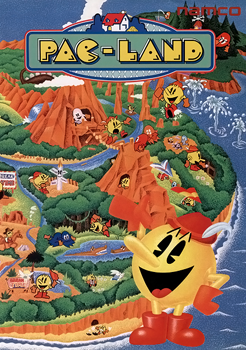Pac-Land
| Pac-Land | |
|---|---|

Japanese arcade flyer of Pac-Land (1984)
|
|
| Developer(s) |
Namco (original) Grandslam Entertainment Mr. Micro |
| Publisher(s) |
|
| Designer(s) | Tsukasa Negoro |
| Programmer(s) | Yoshihiro Kishimoto |
| Artist(s) | Hiroshi Ono |
| Composer(s) | Yuriko Keino |
| Series | Pac-Man |
| Platform(s) | |
| Release date(s) |
August 1984
|
| Genre(s) | Platform game |
| Mode(s) | Up to 2 players, alternating turns |
| Cabinet | Upright, cabaret, and cocktail |
| Arcade system | Namco Pac-Land |
| CPU | 1x Motorola M6809 @ 1.536 MHz, 1x Hitachi HD63701 @ 1.538461 MHz |
| Sound | 1x Namco WSG @ 1.536 MHz |
| Display | Horizontal orientation, Raster, 288 x 224 resolution |
Pac-Land (パックランド Pakku-Rando?) is an entry in the Pac-Man series of arcade video games, released into arcades by Namco, and its American distributor Bally Midway (later Midway Games), in August 1984. It was the first Namco arcade game to use the then-new arcade system later titled as Namco Pac-Land. Pac-Land features parallax scrolling for some of the background elements, a feature that would not become commonplace until the 16-bit console era began much later.
In the Japanese release by Namco, the Pac-Man sprite resembles the official artwork of the character with a longer nose, Pac-Man-shaped eyes, and (for this game) a Tyrolean hat with a feather. In the American release of Pac-Land by Bally Midway, the characters' appearances are based on the designs from the Pac-Man animated series produced by Hanna-Barbera to promote the animated series, as well as the video game series. In addition, both versions feature the main background music and "jingles" from the aforementioned series. Midway's version also features faster game play than Namco's.
Pac-Land itself is split into trips. In each of these trips the objective is to get the fairy (that is kept under Pac-man's hat) to Fairyland and also to return home to Pac-Man's house. The majority of the trip involves moving from left to right avoiding various obstacles such as the enemy ghosts, water spurts and quicksand traps. Each trip is divided into a number of rounds, the end of which provides Pac-Man with bonus points depending on how much time he has left and also his position in jumping at the end of each round. If the player runs out of time before finishing the round, Sue, the purple ghost, will speed up rapidly.
...
Wikipedia
